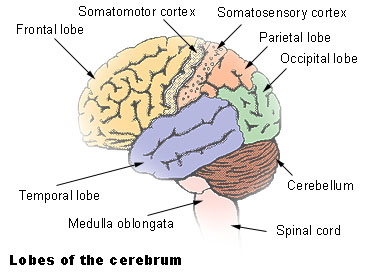Brain
Cerebrum
The cerebrum is the part of the brain that receives and processes conscious sensation, generates thought, and controls conscious activity. It is the uppermost and largest part of the brain and is divided into left and right hemispheres, which are joined by and communicated through the corpus callosum.
Each cerebral hemisphere is divided into five lobes, four of which have the same name as the bone over them: the frontal lobe, the parietal lobe, the occipital lobe, and the temporal lobe. A fifth lobe, the insula or Island of Reil, lies deep within the lateral sulcus.

Cerebellum
The Cerebellum is a cauliflower-shaped section of the brain located in the hindbrain, at the bottom rear of the head, directly behind the pons. The cerebellum is a complex system mostly dedicated to the intricate coordination of voluntary movement, including walking and balance. Damage to the cerebellum leaves the sufferer with a gait that appears drunken and is difficult to control.
Ventricles and Cerebrospinal Fluid
A series of interconnected, fluid-filled cavities called ventricles lie within the brain. The fluid is cerebrospinal fluid (CSF), which also circulates over the outside of the brain and spinal cord.
Brain Stem
The brain stem is the part of the brain continuous with the spinal cord and comprising the medulla oblongata, pons, midbrain, and parts of the hypothalamus.
Tentorium
The tentorium is a fold of the dura mater, which separates the cerebellum from the cerebrum, and often encloses a process or plate of the skull called the bony tentorium.
For more information about anatomy of brain and CNS, go to the Nervous System section of the Anatomy & Physiology module on this Website.
Suggested Citation
SEER Training Modules: Brain. U.S. National Institutes of Health, National Cancer Institute. Cited 26 December 2025. Available from: https://training.seer.cancer.gov.




